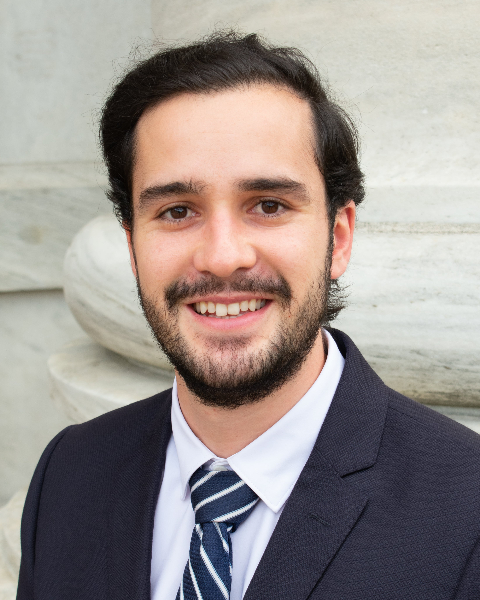PQA 07 - PQA 07 Gastrointestinal Cancer and Sarcoma/Cutaneous Tumors Poster Q&A
3005 - Patterns of Recurrence in High-Risk Gastric Cancer: Defining the Role of Postoperative Radiation
Tuesday, October 1, 2024
12:45 PM - 2:00 PM ET
Location: Hall C
Screen: 17

Juan Jose Juarez Vignon Whaley, MD
Beth Israel Deaconess Medical Center
Boston, MA
Presenter(s)
J. J. Juarez Vignon Whaley1, B. Vidal2, J. Willcox3, and M. J. Abrams4; 1Department of Medical Oncology, Beth Israel Deaconess Medical Center, Harvard Medical School, Boston, MA, 2Department of Pathology, Beth Israel Deaconess Medical Center, Harvard Medical School, Boston, MA, 3Department of Radiation Oncology, Beth Israel Deaconess Medical Center, Boston, MA, 4Department of Radiation Oncology, Beth Israel Deaconess Medical Center, Harvard Medical School, Boston, MA
Purpose/Objective(s): Gastric cancer (GC) is a global issue often diagnosed at a late stage coupled with a poor prognosis. Patients with locally advanced disease are often treated with preoperative or perioperative chemotherapy, however, the ideal postoperative treatment regimen in patients who have a poor response to preoperative chemotherapy is not well defined. The purpose of this study is to map the patterns of recurrence for patients with gastric cancer with a poor response to neoadjuvant chemotherapy and identify a potential role for postoperative radiation. Materials/
Methods: This was a retrospective single institution study analyzing patterns of recurrence in patients diagnosed with locally advanced GC between 2013-2021 treated with neoadjuvant chemotherapy followed by surgery and found to have a poor response to preoperative chemotherapy (ypT3 and/or ypN+). Patients who received radiation were excluded.
Results: A total of 24 patients met the inclusion criteria. Mean age of diagnosis was 62.2 years old, 66% males and 33% Asian. The most common tumor location was the antrum (11 patients), and average tumor size was 4.9cm. The most common neoadjuvant chemotherapy regimen was EOX (5 patients) followed by FOLFOX (4 patients) and FLOT (4 patients). Subtotal gastrectomy with lymphadenectomy was the most common surgery (14 patients). Pathologic tumor evaluation post neoadjuvant chemotherapy and surgery categorized 12 tumors as grade 3, 16 had lymphovascular invasion, 13 perineural invasion and 4 tumors were HER2 +. Eleven patients were ypT4, 7 patients ypN1 and 6 patients ypN2. Local/regional recurrence was defined as recurrence in a standard postoperative radiation therapy field which included the resection bed, remnant stomach/GE junction, regional nodes, and/or splenic hilum. In our population, 50% of patients (12/24) had a documented first recurrence with a median time to recurrence of 26.6 months (95%CI 9.2-NR). Out of those 12 patients, 3 (25%) had local/regional recurrence only, 5 (42%) had distant recurrence only, and 4 (35%) had both. Over half (58%) of patients had a local/regional recurrence as a component of first failure. The most common site of local/regional recurrence was the regional nodes, and distant recurrence was the peritoneum/liver.
Conclusion: This single institution cohort study demonstrates a high risk of recurrence in patients with gastric cancer with a poor response to neoadjuvant chemotherapy, of which, the majority (58%) had a local/regional recurrence as a component of their first failure, within a standard postoperative radiation therapy field. These patients should be considered for postoperative radiation.
Purpose/Objective(s): Gastric cancer (GC) is a global issue often diagnosed at a late stage coupled with a poor prognosis. Patients with locally advanced disease are often treated with preoperative or perioperative chemotherapy, however, the ideal postoperative treatment regimen in patients who have a poor response to preoperative chemotherapy is not well defined. The purpose of this study is to map the patterns of recurrence for patients with gastric cancer with a poor response to neoadjuvant chemotherapy and identify a potential role for postoperative radiation. Materials/
Methods: This was a retrospective single institution study analyzing patterns of recurrence in patients diagnosed with locally advanced GC between 2013-2021 treated with neoadjuvant chemotherapy followed by surgery and found to have a poor response to preoperative chemotherapy (ypT3 and/or ypN+). Patients who received radiation were excluded.
Results: A total of 24 patients met the inclusion criteria. Mean age of diagnosis was 62.2 years old, 66% males and 33% Asian. The most common tumor location was the antrum (11 patients), and average tumor size was 4.9cm. The most common neoadjuvant chemotherapy regimen was EOX (5 patients) followed by FOLFOX (4 patients) and FLOT (4 patients). Subtotal gastrectomy with lymphadenectomy was the most common surgery (14 patients). Pathologic tumor evaluation post neoadjuvant chemotherapy and surgery categorized 12 tumors as grade 3, 16 had lymphovascular invasion, 13 perineural invasion and 4 tumors were HER2 +. Eleven patients were ypT4, 7 patients ypN1 and 6 patients ypN2. Local/regional recurrence was defined as recurrence in a standard postoperative radiation therapy field which included the resection bed, remnant stomach/GE junction, regional nodes, and/or splenic hilum. In our population, 50% of patients (12/24) had a documented first recurrence with a median time to recurrence of 26.6 months (95%CI 9.2-NR). Out of those 12 patients, 3 (25%) had local/regional recurrence only, 5 (42%) had distant recurrence only, and 4 (35%) had both. Over half (58%) of patients had a local/regional recurrence as a component of first failure. The most common site of local/regional recurrence was the regional nodes, and distant recurrence was the peritoneum/liver.
Conclusion: This single institution cohort study demonstrates a high risk of recurrence in patients with gastric cancer with a poor response to neoadjuvant chemotherapy, of which, the majority (58%) had a local/regional recurrence as a component of their first failure, within a standard postoperative radiation therapy field. These patients should be considered for postoperative radiation.
